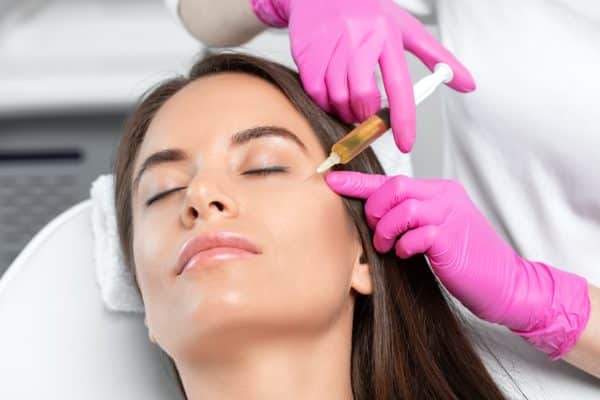PRP injections offer a unique approach to skin rejuvenation by stimulating, regenerating, and repairing the natural production of collagen within the skin, restoring its innate plumpness and vitality.
Targeting aging areas of the face, PRP injections introduce specialized fibrin to create a healthier foundation of collagen, resulting in skin that looks and behaves more youthful.
The PRP procedure begins with a painless blood draw, followed by centrifugation to create a matrix containing skin-reviving platelets, plasma, fibrin, and white blood cells. This matrix is then injected into areas of the face affected by aging. PRP is often combined with other rejuvenating treatments like microneedling and lasers to enhance results.
Once injected, the PRP solution gradually releases growth factors that stimulate collagen production within the skin. This slow release is believed to yield superior results compared to the sudden release associated with PRP. PRP treatment addresses various aging-related skin concerns, including uneven skin tone, fine lines, wrinkles, mild sagging, and enlarged pores.


As PRP treatment involves a gradual release process, achieving optimal results often requires multiple sessions. Typically, patients undergo three to four injection sessions spaced approximately one month apart, although some may require more than six treatments. The number of sessions needed is influenced by factors such as the degree of aging and the quality of the skin's collagen.
Initial results typically become noticeable after about six weeks, as collagen production is a cumulative process. Consistency with treatments plays a crucial role in stimulating collagen production, leading to further improvements in skin texture and appearance. Following the initial treatment series, maintenance sessions every three to 12 months are typically advised to sustain the benefits of PRP therapy.
Platelet-rich plasma (PRP) is used for hair restoration through a minimally invasive procedure known as PRP therapy or PRP injection therapy. Here's how it works:
PRP therapy for hair restoration is believed to increase blood flow to the scalp, nourish hair follicles, prolong the growth phase of hair, and minimize hair loss. It is commonly used to treat conditions such as androgenic alopecia (male pattern baldness and female pattern hair loss) and other forms of hair thinning or loss. Multiple sessions of PRP therapy spaced several weeks apart are usually recommended to achieve optimal results.
Good candidates for PRP injections for skin rejuvenation and hair restoration typically include individuals who:
However, it's essential to consult with a qualified healthcare provider to determine if PRP therapy is suitable for your specific needs and medical history. They can assess your candidacy based on factors such as your overall health, the severity of your skin or hair concerns, and any potential risks or contraindications.